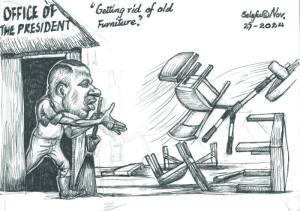The local currency sank to possibly its lowest ever level against the dollar this week, stopping shy of USD/P13, after the greenback surged against global currencies, BusinessWeek has established.
Bank of Botswana indicates that the pula began the week at USD/P12.67, before dropping further to USD/P12.77 on Tuesday and then recovering marginally to USD/P12.72 by Wednesday press time. The pula began the year at P11.79 against the dollar, having shed nearly nine percent against the greenback in 2021.
Prior to this week’s fall, available data indicates that the pula had already lost 8.3 percent against the dollar since January.
The level of USD/P12.77 reached on Wednesday is the lowest the pula has ever sank against the dollar, according to available records from the Bank of Botswana and other open data sources dating back at least 20 years.
The drop in the pula’s strength against the dollar was due to the dollar’s ongoing surge against global currencies, mainly as a result of aggressive interest rate increases by monetary policy authorities in Washington DC.
This week, analysts said the interest rate increases had made the dollar more attractive to investors, causing outflows from other major currencies to the greenback. This, in turn, impacted the pula whose value is gauged by the movements of a basket of major trading partners’ currencies that include the dollar, the rand, and others.
The US Federal Reserve, that country’s central banking system, has been hiking interest rates to counter rising inflation and the threat of even faster growth in the prices of goods and services as a result of the war in Ukraine and COVID-19-related supply chain issues.
“The other reason for the surging US dollar is because it is a classic safe haven when the world is worried about a recession – and the current geopolitical situation is arguably making it still more appealing,” economists at Sheffield Hallam University wrote in an article published in The Conversation this week.
For the local economy, the rising dollar means higher fuel price pressure as the greenback is the oil industry’s currency of trade. Motorists who have already endured eight increases in pump prices since January 2021 could face further upward reviews, particularly as global crude and refined oil prices are already at elevated levels due largely to the effect of the war in Ukraine.
“Further increases in pump prices will obviously raise prices of goods and services across the economy while spurring demands for higher wages by workers, which is inflationary as well,” a local analyst told BusinessWeek. “The other side of the coin is that a strong US dollar improves the price allure of our diamonds and the US is the biggest market for the mineral. “However, it’s difficult to gauge whether those benefits will be seen, in an atmosphere where high US inflation is undercutting consumer demand in that market and where there is a threat of a global recession.”
Meanwhile, the pula has been gaining against the rand, as the local currency has fallen against the dollar, as a result of the workings of the crawling peg system used to gauge the value of the pula.
While the pula has shed nearly two percent against the rand since January, the local currency has been on an uptrend against the South African currency in the last 30 days, gaining about 3.5 percent.
Traditionally the crawling peg mechanism means the pula tends to gain against the rand when it loses against the dollar and vice versa.
The crawling peg system produces the pula’s value by linking it to a basket of other currencies, which include the dollar, pound, euro, rand, and others. The system uses prevailing and forecast inflation in such countries and adjusts for levels of trade.
Each year, the Finance ministry releases the rate of crawl for the pula, which is the rate at which marginal increases or decreases are made to the pula’s value based on inflation within the basket. This year, the rate of the crawl is a downward 2.8 percent, which involves marginally weakening the local currency in order to boost export competitiveness.








